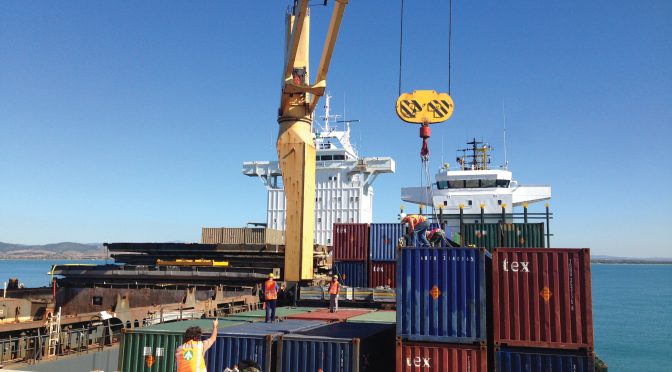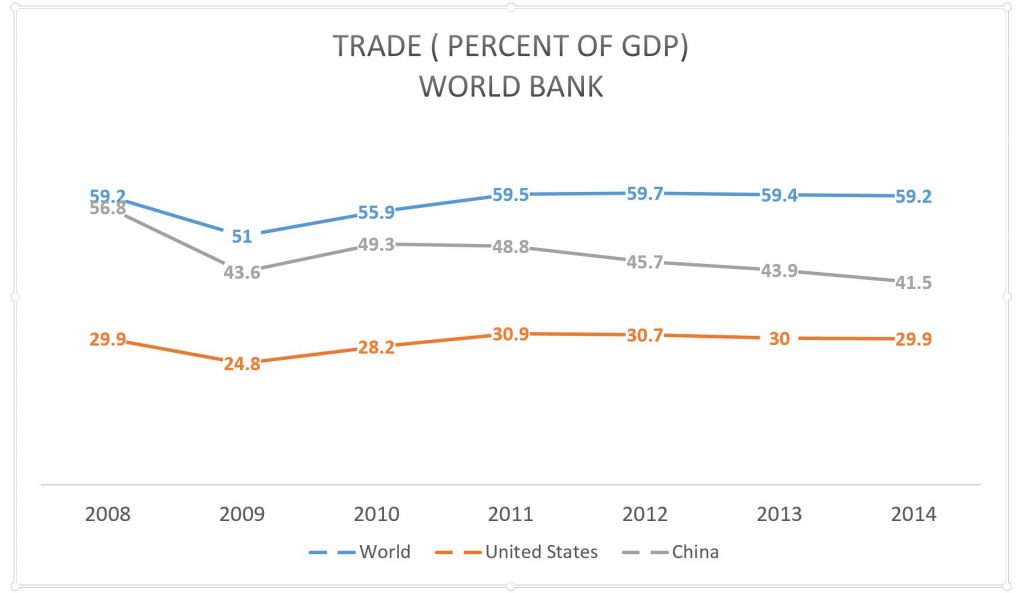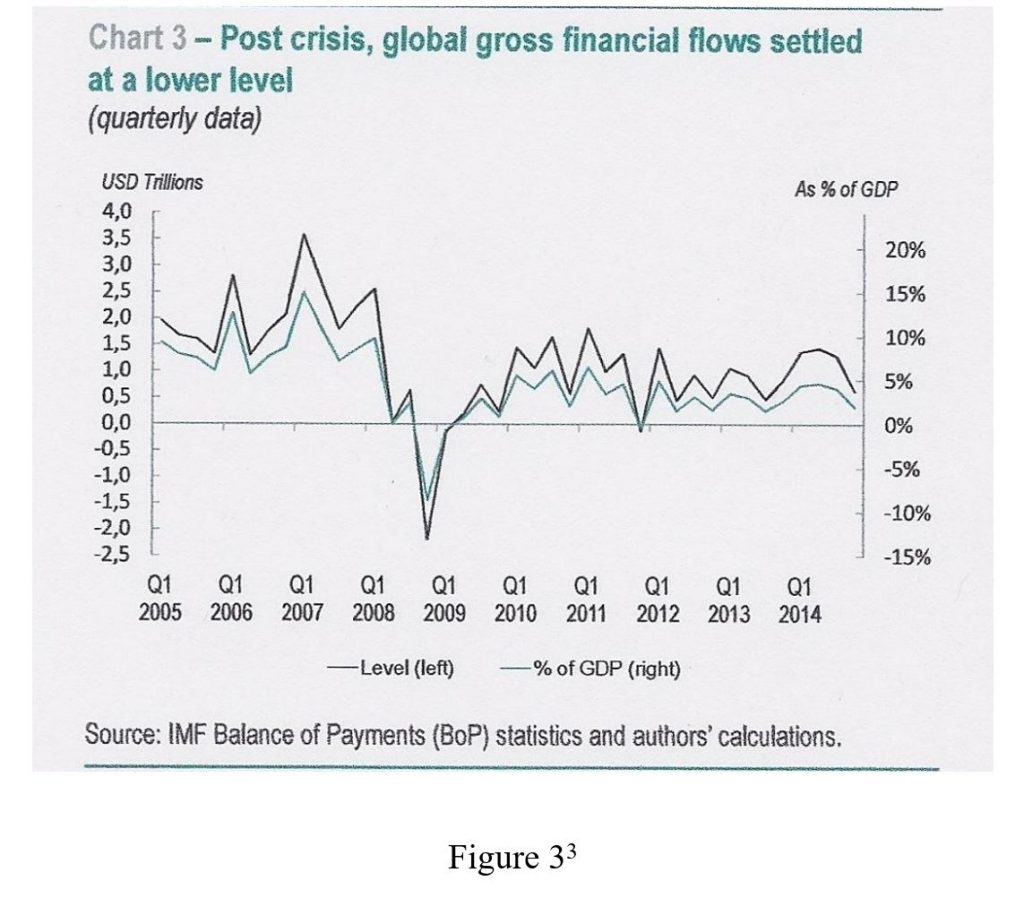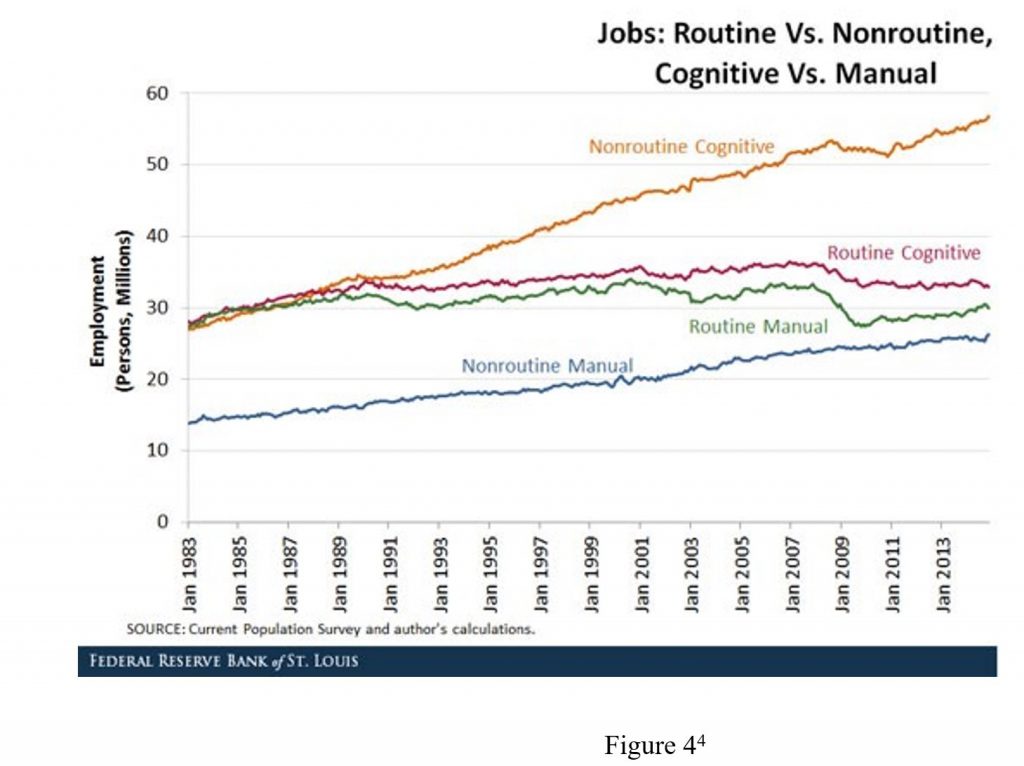The following article is adapted from a report for the Institute for International Strategic Studies at the National Defense University, International Studies, Will Technological Convergence Reverse Globalization?
By T. X. Hammes
Since the end of World War II, the United States has consistently supported greater global integration. U.S. leaders saw this as the route to both prosperity and security. After the shock of Korea, the United States consistently forward deployed its armed forces to support this policy. The following decades of increasing global trade seem to validate this strategy. However from 2011 to 2014, manufacturing trade as a percentage of GDP actually flattened and then declined from 2011 to 2014. Services and financial flows followed the same pattern. In its 2016 report, Mackenzie Global Institute reported, “After 20 years of rapid growth, traditional flows of goods, services, and finance have declined relative to GDP.”
Figure 11
Many analysts contend these are short term trends and soon trade will resume growing. In contrast, this article will argue that the convergence of new technologies is dramatically changing how we make things, what we make, and where we make them. These technologies plus trends in energy production, agriculture, politics, and internet governance will result in the localization of manufacturing, services, energy, and food production. This shift will significantly change the international security environment and in particular the role of the U.S. naval forces.
How We Make Things
The cost advantages derived from the combination of robotics, artificial intelligence, and 3D printing is driving production to automated factories. According to Boston Consulting Group, about 10 percent of all manufacturing is currently automated, but this will rise to 25 percent by 2025. This is only the very front end of the shift of labor to automation. A Price Waterhouse Cooper survey showed 94 percent of CEOs who had robots say the robots increased productivity.
Even as robots are changing traditional manufacturing, 3D printing, also known as additive manufacturing, is creating entirely new ways to manufacture a rapidly expanding range of products – from medical devices to aircraft parts to buildings. In April 2016, Carbon3D released the first commercial version of a machine that prints 100 times faster than its predecessors.
Commercial firms are exploiting these advances. United Parcel Service established a fully-automated facility with 100 3D printers to manufacture one-off parts or mass produce thousands of the same part. “UPS can see a major change coming. The concept is simple, local production of a vast number of components will hit the international shipping market hard.”
In fact, Price Waterhouse Cooper surveyed over 100 industrial manufacturers and reported that fifty-two percent of the CEOs surveyed expect 3D printing to be used for high volume production in the next 3-5 years.
What We Will Make
3D printing will have two other major impacts — mass customization and design for purpose. Rather than stocking the wide variety of parts in the spectrum of colors and finishes they use, a range of industries are looking to maintain only digital files and print on demand. More revolutionary, designers can now design an object to optimally fulfill its purpose rather than to meet manufacturing limitations. General Electric replaced jet engine fuel nozzles made from 18 smaller parts with a single, lighter, stronger, longer lasting, and cheaper 3D printed part.
3D printing can also increase the strength of a product through honeycomb construction, like that of bird bones. Very difficult to make with traditional manufacturing, 3D printing can make them with relative ease. Further, 3D printing can create gradient alloys which expand the material properties of the product. 3D printing can actually improve the performance of existing materials. 3D printed ceramics can have 10 times the compressive strength of commercially available ceramics, tolerate higher temperatures, and be printed in complex lattices, further increasing the strength to weight ratio.
Where We Make Things
The combination of robotics, artificial intelligence, and 3D printing means “on-shoring,” returning manufacturing to the home market, is increasing rapidly. In 2015 survey of CEOs, Boston Consulting Group noted:
–a 17 percent increase in the number that report they are actively reshoring now, which is 2.5 times the number actively reshoring in 2012.
–31 percent would put new capacity to serve the U.S. in the U.S. versus 20 percent who would choose China. A reversal from 2 years ago when China was favored 30 percent to 20 percent.
–71 percent believe that advanced manufacturing technologies will improve the economics of localized production.
The trends noted in Boston Consulting Group’s survey are reflected in the reversal of manufacturing job trends over the past two decades. The United States lost manufacturing jobs every year from 1998 to 2009 — a total of 8 million jobs. But in the last six years, it regained about 1 million of them.
Co-location reduces shipping and inventory costs. It also allows closer interaction between design and manufacturing which speeds the design, test, build, employ, and improve cycle. General Electric just finished building an Advanced Manufacturing Works right next to a large manufacturing plant to both take advantage of proximity and learn more about how to maximize that benefit.
Hal Sirkin, an analyst with Boston Consulting, predicts “you’re going to see more localization rather than more scale… I can put up a plant, change the software and manufacture all sorts of things, not in the hundreds of millions but runs of five million or ten million.” The bottom line is that more and more products will be produced locally, which will steadily reduce the need for international trade in manufactured goods.
Service Industries Are Coming Home Too
Service industries are following suit as artificial intelligence takes over more high order tasks. Pairing AI with humans has resulted in lower costs (fewer humans) and higher customer satisfaction for United Services Automobile Association’s call center.
Nor is artificial intelligence limited to routine call center tasks. This year the Georgia Institute of Technology employed a software program named “Jill Watson” as a teaching assistant for an online course without telling the students. All of the students rated Ms. Watson as a very effective teaching assistant. None guessed she wasn’t human. Baker & Hostetler, a law firm, announced it has hired her ‘brother,’ Ross, also based on Watson, as a lawyer for its bankruptcy practice.
Artificial intelligence is already handling tasks formerly assigned to associate lawyers, new accountants, new reporters, new radiologists, and many other specialties. In short, non-routine tasks – whether manual or cognitive – will still be done by humans while routine tasks – even cognitive ones – will be done by machines. And this is not a new phenomenon, computer technology has been eating jobs since 1990.
With labor costs much less of an issue, better communications links, better infrastructure, more attractive business conditions, and effective intellectual properly enforcement, services are returning to developed nations. The few, more complex questions that require human operators are better handled by native language speakers intimately familiar with the culture.
Only the First Step?
The changes in manufacturing and services may be only the first step in de-globalization. Electric/hybrid vehicles, alternative energy technologies, and increased energy efficiency are reducing the global movement of coal and oil. While starting from a small base, renewable energy — wind, solar, thermal — is growing very rapidly. In 2014, 58.5 percent of all new additions to global power systems were renewables. In 2015, 68 percent of the new capacity installed in the United States was renewable. As vehicle fuel efficiency, hybrids, and all-electric vehicles improve, Wood Mackenzie suggests that U.S. gasoline demand could fall from 9.3 million barrels/day to 6.5 million barrels/day by 2035. Fracking, alternative energy, and new efficiencies have already dramatically reduced the U.S. need for imported energy. If other nations can make similar advances in these areas, it will slow and then reduce the global trade in gas and oil.
Agriculture is another area that has seen increased global trade over the last few decades. High value fruits, vegetables, and flowers move from nations with favorable growing conditions to those without. However, indoor farming has begun to undercut this trade by providing locally produced, fresher, organic products. Depending on the product, such farms can produce 11-15 crop cycles per year. A facility in Tokyo produces 30,000 heads of lettuce per day and plans a second plant to produce 500,000 head of lettuce daily within 5 years. Now that the concept has been proven, Japanese firms are putting 211 unused factories into food production.
The industry is not restricted to Japan. A firm in the United States is planning to establish 75 indoor factory farms. Similar urban farms are being built across Europe and Russia. These indoor farms do not require herbicides or pesticides, use 97 percent less water, waste 50 percent less food, use 40 percent less power, reduce fertilizer use, reduce shipping costs, and are not subject to weather irregularities. Scaled-up, these processes will seriously reduce the market for long-range shipping of high value agricultural products. Japanese firms are even experimenting with growing rice in a number of their facilities.
All of the factors listed above are being reinforced by social pressures to “buy local” to reduce the environmental impact of production. Local production both creates jobs near the consumer and dramatically reduces transportation energy and packaging waste. Indoor farming can almost eliminate the environmental impact of farming on land and waterways.
A further driver of global fragmentation is the effort by authoritarian governments to segment the internet. Initially considered an impossible goal, China has steadily improved its ability to control what people can access inside its territory. Totalitarian nations have decided the costs of connectivity exceed the benefits of globalization. Restricted access to the internet will inevitably reduce these nations’ participation in the global economy.
Cumulative Effects
The key question is how much will the sum of shifts in manufacturing, automation of services, localization of power, and food production reduce globalization. Localizing production will dramatically reduce traffic in components and finished manufactured products thus disrupting established trade patterns. Currently we ship raw materials to one country. It puts together the sub-assemblies, packs them, and ships them to another country for assembly. There they complete the assembly and packaging, then ship the packaged product onward to the consuming country. With the emergence of 3D manufacturing, we will ship smaller quantities of raw materials to a point near the consumer, produce them, and then ship them short distances for consumption. Thus reducing international trade. The localization of energy production and return of high value agriculture to developed nations will further reduce global trade.
Other factors are slowing globalization. First, protectionism is growing. Since 2008, more than 3,500 protectionist measures and administrative requirements have been instituted globally. As technology eliminates jobs, the political pressure for protectionism will rise. Donald Trump and Hillary Clinton both oppose the Trans-Pacific Partnership. Its Atlantic counterpart, the Transatlantic Trade and Investment Partnership, is still being negotiated but faces growing political opposition on both sides of the Atlantic. Brexit probably has killed it.
American policy makers and economists still believe global trade is essential. But according to a recent Pew poll, only 17 percent of Americans thought it leads to higher wages, only 20 percent believed it created new jobs.
Implications for National Security
Since 1945, the United States has pursued globalization for both economic and security reasons. Today, the economic premise of globalization is being challenged by a wide range of political actors. Thus, whichever party wins the next election will likely encourage each of the trends discussed in this paper with tax breaks, trade policy, and administrative actions. The cumulative effect will be to discourage and undermine the case for globalization while potentially strengthening the U.S.-Canada-Mexico trading bloc. Similar pressures may drive nations across the globe to regional trade blocks.
In turn, if globalization no longer has major economic benefits for the United States, then employing U.S. power in an effort to maintain global security will be seen purely as a cost. This will create a very different domestic environment for the practice of U.S. foreign policy. Deglobalization will reduce the American people’s interest in propping up global stability at exactly the time the widespread dissemination of smart, cheap weapons will significantly increase the costs of doing so. Faced with growing social and infrastructure needs, Americans may no longer be willing to underwrite international security with their blood and treasure.
Turning isolationist would reverse over 60 years of American foreign and security policy and radically alter the international security picture. Europeans, already struggling with the implications of Brexit, will have to determine which threat – mass migration or Russian expansion – is the greater one and how they will reach agreement on allocation of security resources.
Asian nations will also face a very different environment. American presence in Asia has been seen as the major provider of stability and peace for the region. Given China’s recent assertiveness in the South China Sea, the biggest question for Asian nations will be how to prevent Chinese domination. In a region with no history of military security alliances, the challenges will be extensive. Some Asian states have the capability to rapidly develop nuclear weapons and may choose to do so to provide nuclear deterrence.
Role of Seaborne Trade in a Regionalized World
Deglobalization will take a decade or two and while it will result in major decreases in international trade, it will not eliminate it entirely. From the U.S. point of view, the import of raw materials and the export of bulk energy, food, and manufactured goods will remain economically important. However, maritime strategists should understand the relatively low percentage of U.S. GDP this represents. In 2014, the United States exported over $1.5 trillion of its $18 trillion GDP. Canada and Mexico accounted for about 35 percent of the total, with most of it shipped overland. The other 65 percent was broadly distributed globally. While 75 percent of those exports by weight were seaborne only 33 percent of exports by value were. This means just under 2 percent of the GDP of the United States was exported by sea and just over 3 percent by air. While mariners faithfully repeat the mantra that 90% of U.S. goods travel by sea, we fail to see the relatively low value to our economy. Thus sustaining support for a global Navy in times of reduced budgets and isolationist sentiment will be a real challenge. Nor will the fact that we import $2.2 trillion per year be a useful argument if isolationist tendencies continue to dominate the political sphere.
So What For The U.S. Navy and Marine Corps
A couple of decades may seem adequate time to prepare if isolationism does come about. It is in fact a very short time for the Department of the Navy. Most of the procurement budgets for the next two decades are effectively obligated to existing and planned programs such as the Ford class, the F-35, and the SSBN replacement. Thus the services must think through how their roles and missions may change in such a future.
Maintaining nuclear deterrence will remain the highest defense priority. However, the combined cost of replacing the triad may force the United States to reconsider whether it needs all three legs. The Navy must be prepared to articulate why the submarine leg of the triad remains important – and deal with the concerns about increasing transparency of the oceans.
In an isolationist America, the next highest priority is likely to be defense of the hemisphere or at least the North American trading block (U.S.-Canada-Mexico). This will require an integrated air, sea, and sub-surface defense of the territory and waters of the region. It will also include protection of undersea fiber optic networks.
A secondary mission will remain the protection of U.S. trade. Even with these increases in manufacturing and energy exports, U.S. exports will likely remain well less than 10 percent of our national economy. Further, these exports will be focused on developed nations in Asia and Europe perhaps reducing the need for naval forces in other regions. Thus the current emphasis on intensive and extensive engagement with navies around the world will be significantly reduced. However, as always, naval forces will often be the force of choice for protection of U.S. facilities or evacuation of U.S. citizens overseas and this will require forward deployed forces.
In an isolationist future, America will not conduct major land campaigns overseas unless absolutely forced to by strategic need. If America chooses to do so, Navy and Marine forces may be the force of choice for initial deployment. The continuance of the small, smart and many revolution means naval forces will have to rethink how they fight. As Professor and retired U.S. Navy Captain Robert C. Rubel noted in 2013,
“Given the increasing sophistication of defenses and the growing expensiveness (and thus smaller numbers) of traditional strike platforms, such as tactical aircraft, the answer to this problem will increasingly involve new kinds of missiles and other unmanned systems. If the Navy, along with the other services, can evolve to a predominantly missile-based, aggression-disruption posture, U.S. influence may be manifested in the inability of unwillingness of dissatisfied power to try to overturn the international order, either regionally or globally, via military means.”
Thus rather than projecting power to dissuade, enemy naval forces might turn to disrupting the opponent’s ability to project power. The convergence of technologies – artificial intelligence, robotics, 3D manufacturing, and drones – will provide thousands of autonomous weapons able to reach out hundreds of miles and even a few that will range thousands of miles. In short, A2/AD will become much more effective and powerful. Fortunately, it can work both ways; strategic geography heavily favors the United States in any contest with China.
A new, old mission may also evolve – Marine Defense Battalions. Developed prior to WWII, they were formed to rapidly establish anti-air and coastal artillery on critical islands. With the exponential increase in range of drones, ASCMs, cruise and ballistic missiles as well as self-deploying sea mines, such forces could create sea denial areas reaching hundreds of miles into the surrounding waters or close maritime chokepoints. These units could be employed in the first island chain to force the Chinese to fight hard if they want to exit the South or East China Seas. Further, they can be used as models for partner and allied nations that wish to build a relatively inexpensive A2/AD capability to raise the cost to China if it attempts to bully them.
Summary
Klaus Schwab, Founder and Executive Chairman of the World Economic Forum writes, “The speed of the current breakthroughs has no historical precedent. When compared with previous industrial revolutions, the Fourth is evolving at an exponential rather than a linear pace. Moreover, it is disrupting almost every industry in every country. And the breadth and depth of these changes herald the transformation of entire systems of production, management, and governance.”
The 4th Industrial Revolution will unfold over the next couple of decades, bringing amazing advances in manufacturing and services. There is no doubt the global economy will change in many ways. Manufacturing, services, energy, and agriculture all seem to be moving to localized production. The net effect is slowing and may be reversing globalization. Obviously, this is not a certainty but it is a strong possibility supported by technical, social, and political trends. If this is happening, the basic assumptions undergirding sixty years of post-World War II prosperity and security will change too. Thus the fundamental assumptions about the role of the U.S. Navy and Marine Corps must also change. As part of their continuing efforts to understand the future, the services must add this possible future and explore what it means.
Dr. T. X. Hammes is a Distinguished Research Fellow at the U. S. National Defense University. The views expressed here are his own and do not reflect the views of the U.S. government. An extended version of this article is available here.
Endnotes
1. World Bank, “Trade ( percent of GDP), http://data.worldbank.org/indicator/NE.TRD.GNFS.ZS/countries/1W-CN-US?display=graph, accessed Mar 29, 2016.
2. World Bank, “Merchandise trade ( percent of GDP), http://data.worldbank.org/indicator/TG.VAL.TOTL.GD.ZS/countries?display=graph, accessed Mar 29, 2016.
3. Matthieu Bussiere, Julia Schmidt, Natacha Valla, International Financial Flows in the New Normal: Key Patterns (and Why We Should Care), CEPII, Mar 2016, p.5, http://www.cepii.fr/PDF_PUB/pb/2016/pb2016-10.pdf, accessed May 26, 2016.
4. Maximiliano Dvorkin, “Job Involving Routine Tasks Aren’t Growing,” St. Louis Federal Reserve Bank, https://www.stlouisfed.org/on-the-economy/2016/january/jobs-involving-routine-tasks-arent-growing, accessed May 25, 2016.
Featured Image: Mariners aboard MSC-chartered cargo ships MV BBC Seattle and MV Marstan conduct cargo operations in Talamone Bay, Italy. (U.S. Navy photo by Matthew Sweeney)





